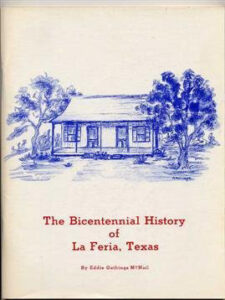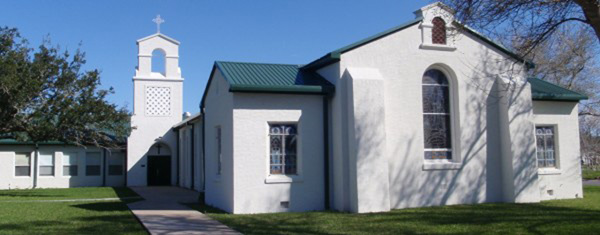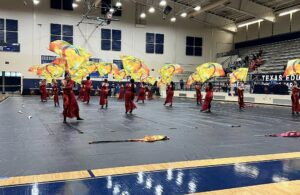- La Feria Community Holds Succesful Business Mixer Event
- Little Nashville to Take Place in Downtown Mercedes
- Lions Basketball Captures District Gold
- La Feria ISD Students Compete in Regional Chess Tournament
- Lions End First Half of 32-4A on a High Note
- La Feria ISD Held Another Successful Parent Conference
- Strong Appearance for Lions at Hidalgo Power Meet
- LFECHS Students Get to Meet Local Actress
- Students Participate in Marine Biology Camp
- Two LFECHS Students Qualify for All-State Band
The Union and the First Methodist Church: Part Three
- Updated: October 9, 2015

The city of La Feria is celebrating its 100th year anniversary and to commemorate the occasion we are digging deep into our archives each week to bring you images and stories from La Feria’s colorful past.
 |
The following story is a chapter from a manuscript entitled The Bicentennial History of La Feria, Texas written by Eddie Gathings McNail in 1975. Throughout the coming year we’ll be reprinting sections of her research into the history of La Feria as the city celebrates its 100 year anniversary. |
Editor’s Note: For the next few weeks we will be publishing Ms. McNail’s prodigeous chapter on the history of La Feria’s First Methodist Church. La Feria News would like to invite the congregations of St. Francis Xavier Catholic Church, New Hope Presbyterian Church of La Feria, and the First Baptist Church of La Feria to please submit any historical photos they may have related to their respective churches. Our archive has many photos of the Methodist church but none of the Catholic and Baptist churches. Please bring any photos by our office or email scans to [email protected]. Thank you!

The church as it looks today. The original building was sold in 1948 and moved to Elsa, Texas to be used as the Mexican American Methodist Church. Photo: laferiafumc.com.
Debts had to be paid and money was needed to continue the building program. Much credit is due the Women’s Society of Christian Service, the Grace Mitchell class and the young adult class for raising money by serving the Rotary Club and by having ice cream socials, turkey suppers, chicken pie suppers, etc.
Some of the farmers gave bales of cotton while others gave money to help pay the debt.
After the debts were paid, the sanctuary was completed part by part. The separate projects consisted of the following: foundation, walls, trusses and roof, concrete floors, stucco and plaster. The cost of each project was estimated, the money was raised by an organization or by a class and then the project was completed. During this time Lowell L. Clark, the vice chairman of the building committee, took the leadership and was the driving force behind the building of the sanctuary.
Plastering the church was the work of Mr. Edward Kratovil for some $1,280.00. The outside had two coats of plaster with waterproofing in the material, the third coat consisted of lime and cement with salt added, and soapy water was used to wet the mix. This waterproofed the outside as well as made a very hard finish.
On the inside was the first hard coat, followed by hard plaster six feet from the floor and acoustical plaster from six feet up in the main south, north and east walls of the sanctuary.
Mr. Kratovil suggested the use of acoustical plaster as called for by the architect. He said that this was the first time he had ever heard of acoustical plaster being troweled. It would soften but not deaden the sound. The voice from the pulpit or anywhere in the chancel would carry well throughout the sanctuary since the troweled plaster eliminates any and all echoes. The hard white plastered wall in which the worship window was set is the sound board to carry the voice out into the sanctuary.
The work of an experienced craftsman is always recognized and appreciated. The work of Mr. Edward Kratovil in this instance was a real work of art.
The worship window was placed in memory of Mr. D. S. Knight who passed to his eternal reward while attending Annual Conference at San Antonio, Texas, in May of 1950. Mrs. D. S. Knight and Leslie A. McDaniel made the selection of the symbol for the window and then got the approval of the committee on windows. Our idea of the symbol was Christ with outstretched hands saying, “Come unto me.” A desired picture was found in a Sunday School quarterly. The facial expression used was chosen from one of the church bulletins. Mrs. Josh Sanders and Mrs. Knight worked out the background, the flagstone walk, the lilies, the clouds, etc. Mr. H. Black combined the suggestions in a rough sketch on a large sheet of paper and returned same for approval. After a few corrections, it was approved by the committee on windows.
The scripture giving the meaning of the symbol is Matthew 11:28-30.
“Come unto me” in the worship window is an invitation to all who enter to worship to truly come to Jesus. Jesus cares, Jesus knows, Jesus understands all of our trials and tribulations, temptations and distresses, sorrows and heartaches, and joy and happiness. It is His desire to share with us in all of life. But for Him to share we must come to Him. Then, we experience His fellowship which gives us peace in mind and in soul. This gives all of us assurance of life eternal. Therefore, it is hoped that this window will help all who worship to find PEACE at the feet of Jesus.
The windows of the sanctuary were designated to be art glass windows. Mr. H. Black of San Antonio met with the committee on windows to make plans for designs and symbols. He sent books and suggestions for the selection of the symbols. After a study of the various symbols, Mrs. Josh Sanders suggested that there be twelve Old Testament symbols and twelve New Testament symbols to portray outstanding progressive events of each. The committee unanimously accepted the idea. The symbols were chosen by the committee with those giving windows in memory of, in honor of and presented by choosing from the symbols selected.
Under the heading of each of the symbols is given the name of the person memorialized or honored and, also, the name of persons or organizations who presented windows. The meaning of each symbol is given; in some instances, only references to Scripture are given as the explanation or meaning of the symbol.
The following was written by Mrs. Peggy Moses Burdine in 1952:
Color Symbols in our Church Windows
Down through the ages, man has tried to show his love of God by building beautiful churches. Even the Solomon of old strove to make his temple the most lovely of the land. No gold was too fine, no fabrics were too delicate to go into this house of God.
And so it is with modern man. We want our churches to be our best and most beautiful examples of architecture. A look about you in the Methodist Church will tell you that it has been most carefully planned. Notice the colorings in the art glass windows.
The principal colors are red, blue, green and white.
Red represents fervency. In olden times, the red-hot heat of charcoals was used to melt even the most obstinate metals and so can the love of God melt even the most obstinate of human hearts.
Blue represents quietness-the quietness that is essential if one is to hear and to know God’s will.
Green represents immortality. Further north, when winter has gone and left the barrenness and desolation in her wake, it isn’t long before nature begins to smile again,-and green things are seen everywhere as a result of nature’s reawakening.
White represents purity—the purity of the life of Jesus Christ while he was here on earth. On Easter Sunday, this purity is symbolized by placing the pure white Easter lily in our churches.
Beginning at the front of the building and continuing east along the north wall, the story of the Old Testament is told.
On the south wall, the story is that of the New Testament. During Rev. McDaniel’s six years, there was a net gain in active membership of 89 or a net gain in the total membership of 56. There was a net gain in Sunday School membership of 95 and a net gain in average attendance of 39. In 1945, all of the church property was worth $15,310.00 and in 1951, $56,000.00.
The first wedding in the new church was that of Miss Virginia Bond and Mr. Gene Smith on May 25, 1951, the second was that of Miss Lee Eva Clark and Mr. Gary May on July 3, 1951 and the third was that of Miss Mary McNail and Mr. Grover C. Williams on August 26, 1951. The Rev. Leslie A. McDaniel returned to perform the last wedding. The altar and the ceiling of the church were not finished.
Soon after Rev. D. S. Dubberly arrived in La Feria in June, 1951, he learned that the members were not satisfied with the windows as they were in the pastor’s study and the choir room.
They were of the same size of those in the educational building and were made of wood and plain glass. Everyone believed that they should be made of the same material as the windows in the sanctuary and rounded at the top. After consulting with the architect, it was found that it would not be practical to make them rounded at the top; however, we did discover that casement windows could be installed if the openings were narrowed. This was done and the casement type of window was placed in trie openings.
After consulting with Mr. Black of San Antonio, it was found that the art glass at the top could be shaped to resemble those in the sanctuary at the price of $125.00. The total cost for labor, materials and art glass came to $750.00.
H. Frank Smith, Bishop in charge of the Houston-San Antonio area, gave the dedicatory address on Sunday, May 15, 1955 at 9 o’clock in the morning. Charles T. Hardt was superintendent of the McAllen District while D. S. Dubberly was pastor.
For the last twenty years, fruit and vegetables have been sent to the Waco Children’s Home as well as cash donations.
Lowell L. Clark headed this committee in the early years and Mrs. John L. McNail for some ten years. Charles Graham and John Mitchell were co-chairmen in 1973 and Jack Goodloe in 1974. The Methodist Church usually sends over a hundred boxes of oranges and grapefruit and sacks of cabbage and a cash donation from the Red Christmas Socks and the White Christmas Party. The Red Arrow Freight Lines, Inc., of Harlingen, with Mr. Nelson Dunn as manager, ships the fruit and vegetables free.
During the four years that the Rev. Leon Brown served the Methodist Church, many worthwhile accomplishments were noted.
The parsonage was being repaired and redecorated when the Browns arrived in La Feria, so they lived in Worcester’s apartment for a time. The attendance at Church School and church was high as there was “The Cowboy Round-up Program” that averaged 221 each Sunday. The services were Church School, Sunday evening service, Methodist Youth Fellowship, choir practice. United Methodist Women, the Grace Mitchell Class, the Men’s Breakfast Club and the Bible Study Class.
Guest speakers during the four years were: Dr. L. O. Ryan who held a revival and Dr. Floyd Curl, a former pastor, who were honored with a reception after church by the Women’s Society of Christian Service.
The Rev. Elmer A. Rader faithfully served the First United Methodist Church for nine years, arriving in La Feria on June 1, 1965. Painting of the church and educational building and the addition of a large bedroom and bath on the parsonage as well as painting of the parsonage inside and out were accomplished during this time. Mrs. John L. McNail, the first lady to be so recognized, was elected chairman of the Administrative Board in 1972.
With no church debt and with a united membership, the church progressed in faith and grew in members.
The membership of the church has risen and fallen since 1909 with 25 members in 1919, 171 members in 1938, 324 members in 1943, 345 members in 1953, 293 members in 1963, 234 members in 1973 and 256 members in 1975.
The First United Methodist Church of La Feria beckons to all the people to take up the light yoke of Jesus Christ and to perform service in His name. May the members meet this challenge now and in the future.
The ministers, servants of God, who have served the Methodist Church have been:
Peter I. King, 1914-1915
0. C. Crow, 1915-1919
L. U. Spellman, 1919-1920
F. M. Miller, 1920-1921
W. B. Woodruff, 1921-1922
E. C. Swann, 1922-1924
B. Y. Dickinson, 1924-1926
J. Virgil Davis, 1926-1927
R. Floyd Curl, 1927-1928
Z. R. Fee, 1928-1929
J. A. Boatman, 1929-1931
C. W. Rylander, 1931-1932
Stanley R. Horwood, 1932-1934
J. C. Wilson, 1934-1937
W. F. Shine, 1937-1938
J. C. Chess Lovern, 1938-1940
Raymond E. Wilson, 1940-1941
S. S. Davis, 1941-1942
Roy H. May, 1942-1945
L. A. McDaniel, 1945-1951
D. S. Dubberly, 1951-1955
William Palmer, 1955-1959
Lawrence Greenhaw, 1959-1961
Leon Brown, 1961-1965
Elmer A. Rader, 1965-1974
Billie Sandefer, 1974-
Do YOU have any photos, books, or stories that might help us piece together La Feria’s storied history? If so please email us or call our office at 956-797-9920 and let us know!


